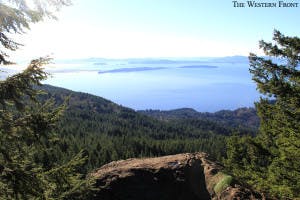
A section of Blanchard Forest containing multiple lakes and hiking trails, including the popular Oyster Dome outlook, is in danger of being logged in the summer of 2017.
In 2007, 1,600 acres of the forest’s core was shielded from commercial logging in the Blanchard Forest Strategy Agreement created between the Washington State Department of Natural Resources, foresters and conservationists. The other 3,600 acres was given to loggers to generate DNR revenue.
The DNR has a financial obligation to relay income from state-owned forests like Blanchard to local receivers, said Kyle Blum, Deputy Supervisor for State Uplands. In this case, the main receiver is our schools in Skagit County, he said.
If a portion of Blanchard’s core is not going to be available for commercial use, beneficiaries need to be compensated for the value of the land and timber, Blum said. The amount required to do this now sits at $14 million and so far only $6.5 million has been raised.
The Blanchard Forest Strategy Group was given five years, starting in 2010, to come up with the money. Since then the trees have grown and a value of $2 million has been added to the original appraisal of $12 million.
Blanchard’s protection agreement expired in September, 2015. The group is currently brainstorming a plan to raise $7.5 million by summer 2017, when the land is slated to go to auction to foresters.
“It’s been a challenge for us to get the Legislature to fully complete the commitment,” Blum said.
Should they fail to raise more money by deadline, Blum says the backup plan is to purchase a section of the core, about 600 acres, that is proportional to what has been raised. The rest would be devoted to logging, compromising the popular network of trails and hiking destinations winding throughout the area.
“There’s good commodity value there and valuable timber,” Blum said. “There are a lot of environmental values in the forest and there are a lot of recreational values.”
Molly Doran, the executive director of Skagit Land Trust, was a part of the Blanchard Forest Strategy Group, which consisted of stakeholders from all sides of the issue. Mount Baker Group of the Sierra Club, Conservation Northwest and recreational enthusiasts all wanted to conserve Blanchard, while those who received the land’s revenues wanted them maintained, Doran said in an email.
“Controversy was really building with folks who did not want to see ongoing timber management in Blanchard Forest,” Blum said.
An overwhelming majority of Blanchard revenues go toward the Skagit County beneficiaries, Blum said . According to a 2014 Skagit Valley State Forest Trust Land report, 58 percent of the $5 million generated that year from DNR Skagit County timber sales went—in one way or another—toward public schools in Skagit County.
Remaining funds were dispersed between other municipal functions including roads, EMTs and hospitals. The DNR’s main focus is maintaining long-term revenue sources such as renewable timber harvesting and short-term agricultural leases, Blum said.
According to Conservation Northwest, the land conserved in the agreement was less than what conservationists wanted and more than foresters wanted to give up.
“I think folks didn’t want to just fight about it and go to court about it,” Blum said. “They wanted to see if there was a common mission that they could all share for management of the forest.”
Craig Romano is an outdoor blogger and enthusiast who’s authored 14 guidebooks and followed the Blanchard Forest issue since the 1990s. Blanchard’s core is too valuable to wildlife and recreation to harvest it for it’s timber, Romano said.
“I live in Skagit County, so I’m not a city person,” Romano said, “I love going outdoors, being in a natural area. I can’t stand the city.”
Romano was given the news by the Skagit Land Trust and Conservation Northwest and has since put the word out on his blog. The current generation is one that tends to monitor Facebook posts and replies, Romano said, but that’s not enough. People need to pick up the phone, call their legislators and be involved in the process, he said.
Romano says there were two camps of people in relation to their knowledge: one camp had no idea about and think Blanchard is a state park, and the other think the agreement was the end of it.
“We thought it’s already a done deal; the compromise was approved,” he said. “We didn’t realize that it’s contingent on the spending that’s coming through.”
Senior Liam Elio said he was disappointed when he heard that Oyster Dome could be subject to logging. Elio is a recreation major at Western and plans excursions for the Outdoor Center, some of which take place in the Chuckanut area.
“In this day and age, any time that we’re moving more toward degradation of our forests and lands versus preservation, it just seems like we should have learned that lesson by now,” he said.
Walking in the woods without seeing massive deforestation can have a powerful affect on people, Elio said.
“It’s magic,” he said. “I don’t understand it, but I know it’s amazing.”
Sophomore Sasha Alden said recreational land is important because it gives people a chance to appreciate nature. Although she has yet to hike Oyster Dome, Alden said recognizes the value of Oyster Dome to the community.
“Ruining that area would really be damaging to the community as a whole because it’s such a landmark for Bellingham,” Alden said.
The Conservation Northwest website offers a pre-written letter and a list of contact information for those who would like to have their voice heard. The website urges community members to take action so that the logging can be prevented.
*Editors Note: This article was corrected from a previous version that attributed quotes from Kyle Blum to Bob Redling. 2/16/16





